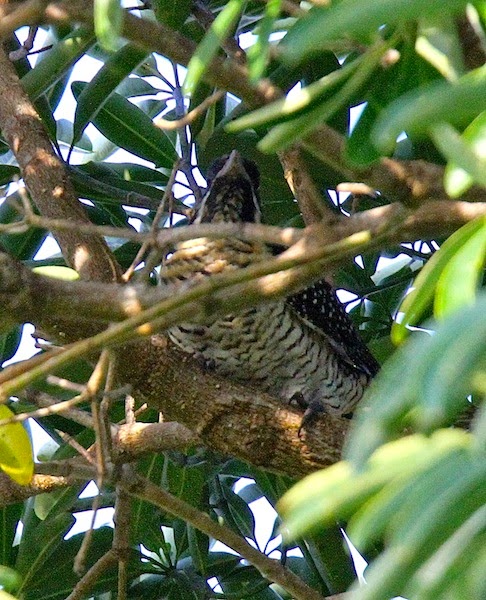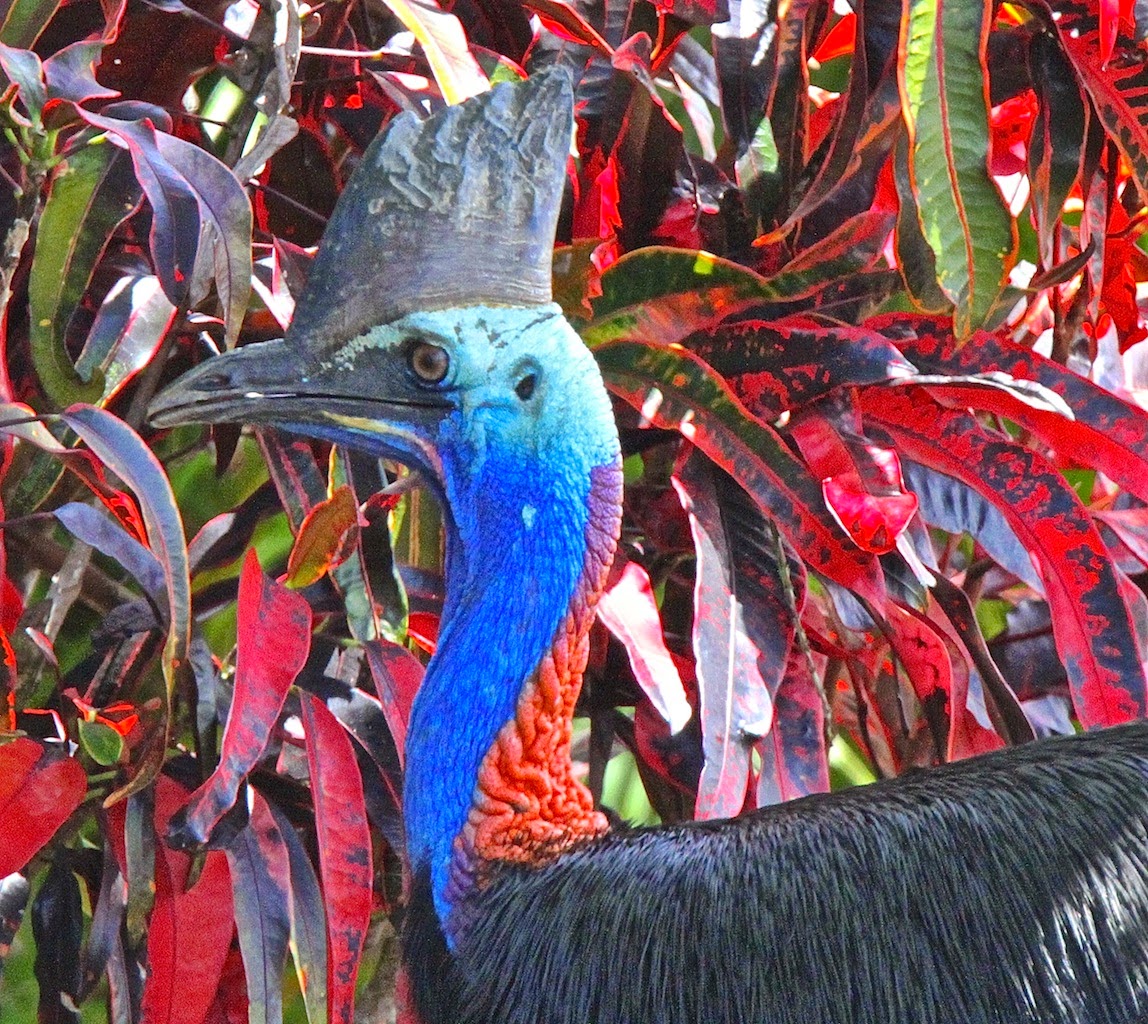It has been three months since any meaningful rain has fallen on the Cassowary Coast, the rainforest is dry and the creeks low with level 3 water restrictions now in force for all the southern water supply areas, while Innisfail which takes its water supply from the Johnstone has level 1 restrictions applied. However, my spring is still delivering good water and best of all with no runoff the Johnstone River is flowing clean and clear to the Great Barrier Reef.
On the banks of the river the footprints of the evening visitors tell the story of their night time excursions, and from the sky the early morning is filled with the excited calls of terns searching for a fishy breakfast.

 Fish boils and swirls break the surface of the river as does a land breeze bringing a welcome coolness to the early morning.
Fish boils and swirls break the surface of the river as does a land breeze bringing a welcome coolness to the early morning.Many years ago a young freelance journalist
 Greg Borschmann, when he stayed here while writing stories on the campaign for World Heritage Listing of the Wet Tropics, would go down to the beach and meditate for half an hour before leaving to head into the heat of the campaign. They were muddy waters then and it is thanks to the talent of writers like Greg that people all over the world were made aware of the beauty of the Wet Tropics Rainforests and the World Heritage Great Barrier Reef.
Greg Borschmann, when he stayed here while writing stories on the campaign for World Heritage Listing of the Wet Tropics, would go down to the beach and meditate for half an hour before leaving to head into the heat of the campaign. They were muddy waters then and it is thanks to the talent of writers like Greg that people all over the world were made aware of the beauty of the Wet Tropics Rainforests and the World Heritage Great Barrier Reef.Today Greg is part of a team of paddlers trying to paddle the entire 405 km of the Murray River. This Murray River Marathon is raising money for the YMCA programs for rural youth. Please join me in helping Greg raise money for Rural Youth and click on the link below.
https://ymcammp14.everydayhero.com/au/gregg-borschmann
Well at last I am able to identify the second cassowary dad with chicks, it is Hero. Unfortunately Hero again lost one of his chicks this year, the surviving chick is so cute and already has defined wattles.
Cassowary Hero was passing through Bill Farnsworth's yard and he took the opportunity to capture these photos for us.
 Apparently Hero has been walking from the rainforest on the coastal side of the range and going down the hill on the western side. To do this he must cross the road and that is when there is always a danger for cassowaries, particularly chicks.
Apparently Hero has been walking from the rainforest on the coastal side of the range and going down the hill on the western side. To do this he must cross the road and that is when there is always a danger for cassowaries, particularly chicks.Cassowary Hero, photo right, is easy to identify because of his striated wattles.
Thank you Bill for these photos and I hope we see lots more photos as this new chick grows.

Nellie Epong caught a glimpse of Cassowary Clara this week. Clara's very long flat wattles and her casque with a slight right turn make this large female easy to ID. Thank you Nellie for the photo it has been a year since I last saw Clara, this female spends most of her time deep within the Moresby Range National Park and we only see her when she is looking around for a mate.
Nellie also got a distance shot of Queenie near the National Park sign. She has been seen reguraly crossing Ninds Creek, using the footbridge. Margaret D watched her walking across the footbridge this week and marvelled at Queenie's good sense, thank you for the information Margaret.

Great photos Nellie thank you for sharing, it is interesting to see the territory Queenie has mapped out for herself although we all miss her back at the Point where she grew up.
I saw cassowary Peggy at the top of the Range this week, she was by herself no sign of Starlight and she looked a little gaunt.
Time will tell if she has completed her courtship with Starlight and he is now sitting on eggs.
Peggy's broken casque make her easy to identify.
Cracked on the right side and rippled on the left.
Peggy walked on the footpath beside the houses at the top of the ridge then crossed the road and went down the Range to the River.

I took some good ID photos of young Cassowary Hope this week. I found him standing in the gutter on the bend leading to the Nind's Creek Bridge. For a young male he is large and looks well conditioned.
He crossed the road into the Moresby Range National Park.

Left and right photos Cassowary
Hope
Thank you JS for suggesting this lovely name for this young bird Hope.

Cassowary Snout and Ky visit the fountain on my front lawn almost every day to drink water and I also often see them when I go for a walk in the rainforest.

Cassowary Jessie is still hanging around stalking Snout, its just a matter of time before he accepts her attention. Jessie's neck colours seem to be particularly strong at the moment.
The cattle egrets are in full mating plumage and they have no difficulty in identifying their mate.


Cattle Egrets play an important role in agriculture by consuming many pest species of insects that are a problem in a wide range of horticultural crops.
Butcher birds are also performing mating displays as their long melodious songs carry across the river and mangroves every morning.

The male common koel has been very vocal this week he has eaten, to almost all of the last fruits of the plentiful fig, ficus copiosa. I watched common koel as he sang a low gentle song, similar to the mating song of the metallic starlings, soft and melodious. I thought perhaps it was a distraction while his mate was trying to place eggs in another bird's nest. This was the first time I had heard common koels make a low sweet consoling song.


Male common
koel, left.
Female
common
koel,
right.


The frenzied gathering of nest material by the metallic starlings is coming to an end as they put the last touches to their nest repairs and new buildings in the White Apple tree, syzygium forte.
 I watched one metallic starling pulling with all his might at a dried piece of vine when it snapped and he went tumbling backwards. Within seconds he regained his foothold and continued his search for nest building material.
I watched one metallic starling pulling with all his might at a dried piece of vine when it snapped and he went tumbling backwards. Within seconds he regained his foothold and continued his search for nest building material.
The fruits of the white apple tree are maturing at the entrance to this metallic starling nest. below.


On Thursday this week my attention was drawn to an unusual bird call coming from high in the melaleuca trees. I looked up and saw three male cicadabirds putting on a display calling and chuckling at each other. At no time did I hear them give a cicada like call, they were not hunting but interacting with each other. After a few minutes they flew off towards the Coquette Point Wetlands. I have not recently seen any females but with three males present they must be somewhere close by.

I did a trip down to the North Barnards this afternoon and did a PIP count on the way.
In the Moresby Range National Park, Coquette Point section I saw a small flock of 10 birds feeding in the canopy. Before Etty Bay we saw three flocks of about 10 birds in each. Towards Mourilyan we saw two flocks of five birds. Approaching Robinson's Beach there was a sudden rising from the rainforest canopy of at least 100 birds before they settled back to feeding. As we approached the North Barnards three birds came to land. At sunset 11 small flocks of about five birds each and one large flock of 50 PIPs flew past the North Barnards and went towards the South Barnards. Some stragglers flying alone and in pairs came in well after sunset about another 10 birds also flying to the South Barnards. This is the lowest count of PIPs I have seen along this part of the coast for this time of the year and that includes the years directly following Cyclones Larry and Yasi.

 |
| Some of around 100 PIP feeding in the rainforest canopy. |
At Coquette Point the most PIPs I have seen this year is a small flock of five birds. They feed on the trees with ripe fruit until all the
 fruit is eaten.
fruit is eaten. On the North Barnards only single PIPs were sighted roosting on the trees. It appeared the 'PIP-party' was on the Southern Islands.
On the North Barnards only single PIPs were sighted roosting on the trees. It appeared the 'PIP-party' was on the Southern Islands. |
| Eight PIPs flying south out from Cowley Beach |


Cyclone damage is still very evident along the coast-line and on the islands. Many trees are dead and climber-towers of vines dominate the canopy, smothering the new growth.
 |
| 23 PIPs flying past North Barnards to the South Barnards 1732 hrs. |
Cheers for this week,
Yvonne.












No comments:
Post a Comment